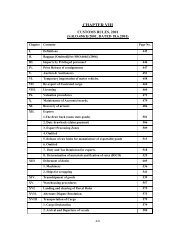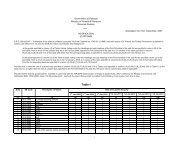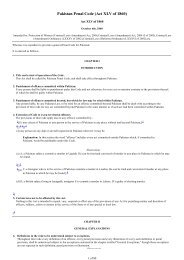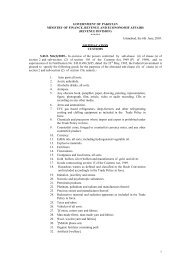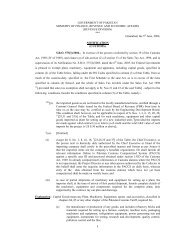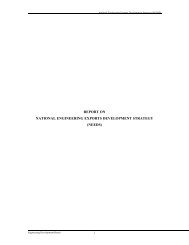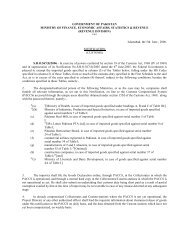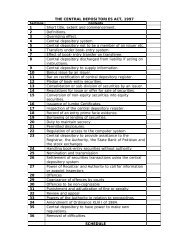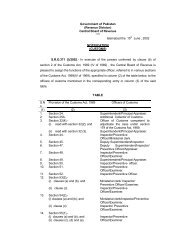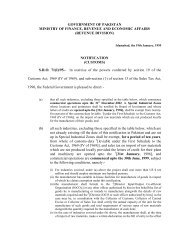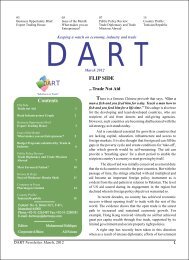47. Pakistan Economic Survey 2011-12 - Consultancy Services in ...
47. Pakistan Economic Survey 2011-12 - Consultancy Services in ...
47. Pakistan Economic Survey 2011-12 - Consultancy Services in ...
You also want an ePaper? Increase the reach of your titles
YUMPU automatically turns print PDFs into web optimized ePapers that Google loves.
Promote and devise methods for harvest<strong>in</strong>gra<strong>in</strong> water us<strong>in</strong>g low-cost structures. Clarify national sanitation policy <strong>in</strong> order tomake it explicit and consistent. Encourage and promote public toilets <strong>in</strong> allurban centres. Develop systems for safe sewage disposal. Awareness rais<strong>in</strong>g and br<strong>in</strong>g<strong>in</strong>g an attitud<strong>in</strong>alchange. Generate resources (locally and nationally) andensure participation of stakeholders. Guide appropriate technical choices. Establish public-private-civil societycollaborative arrangements.Accord<strong>in</strong>g to a report released by theWHO/UNICEF Jo<strong>in</strong>t Monitor<strong>in</strong>g Program (JMP)20<strong>12</strong>, <strong>in</strong> <strong>Pakistan</strong> 92 percent people had ga<strong>in</strong>edaccess to source of dr<strong>in</strong>k<strong>in</strong>g water by 2010 whilethis ratio was 85 percent and 89 percent <strong>in</strong> 1990and 2000 respectively. The MDG target is toachieve the ratio of 93 percent by 2015. Moreover,48 percent people have been us<strong>in</strong>g improvedsanitation by 2010 while this ratio was 27 percentand 37 percent <strong>in</strong> 1990 and 2000 respectively. TheMDG target for access to sanitation is 90 percentby 2015.ForestCurrently <strong>Pakistan</strong> has only 5.17 percent of totalland area covered with forest plac<strong>in</strong>g <strong>Pakistan</strong>among countries with low forest cover. Thecountry’s forest area is divided <strong>in</strong>to state-ownedforests, communal forests and privately ownedforests. Major forest types exist<strong>in</strong>g <strong>in</strong> <strong>Pakistan</strong> aretemperate and subtropical conifer forests, scrubforests, river<strong>in</strong>e forests (irrigated plantations), l<strong>in</strong>erplantation (roadside, canal-side) and mangroveforests. The exist<strong>in</strong>g forest resources <strong>in</strong> the countryare under severe pressure to meet the fuel-woodand timber needs of a rapidly grow<strong>in</strong>g population.In addition to this, the wood based <strong>in</strong>dustries<strong>in</strong>clud<strong>in</strong>g hous<strong>in</strong>g, sports, matches and furnitureare cont<strong>in</strong>uously grow<strong>in</strong>g.EnvironmentForests and REDD+(Reduc<strong>in</strong>g Emissions from Deforestation andDegradation plus)Increas<strong>in</strong>g GHG emissions are contribut<strong>in</strong>g toglobal warm<strong>in</strong>g and lead<strong>in</strong>g to accelerated climatechange. The REDD+ <strong>in</strong>itiative facilitates tradebetween developed countries who are net emittersof GHG and the develop<strong>in</strong>g countries who are netnon-emitters, s<strong>in</strong>ce they do not have heavy<strong>in</strong>dustry that produce carbon but have forests thatcan stock excess carbon <strong>in</strong> the air. Under REDD+mechanism, the emitters may trade their carbon tobe consumed/stocked by forests <strong>in</strong> develop<strong>in</strong>gcountries at a per ton cost to be calculated as perCertified Emission Reduction (CER). This processbuilds a nexus between climate change and forestcarbon credits. Therefore, the concept of REDD+was developed as an <strong>in</strong>centive based mitigationresponse from the Montreal Climate ChangeNegotiations (COP 11) <strong>in</strong> 2005 to address 17-25percent reported global share from deforestationand forests degradation. This will <strong>in</strong>volveenhanc<strong>in</strong>g exist<strong>in</strong>g forests and <strong>in</strong>creas<strong>in</strong>g forestcover. This concept has three important phases: Read<strong>in</strong>ess phase (2010-20<strong>12</strong>): enact<strong>in</strong>gnational strategies supported by appropriatecapacity build<strong>in</strong>g Pilot phase or Investments phase: ‘learn<strong>in</strong>gby do<strong>in</strong>g’ through pilot projects. This isunderway <strong>in</strong> some countries, before theenactment of <strong>in</strong>ternational rules. Implementation or Operations phase (2013-2020): performance-based payments are made,either by direct fund<strong>in</strong>g or via l<strong>in</strong>ks to theglobal carbon market, lead<strong>in</strong>g to the globalimplementation of REDD+.REDD+ Potential and <strong>Pakistan</strong>:<strong>Pakistan</strong> has a low forest cover with diversifiedforest types from coastal mangrove and river<strong>in</strong>eecosystem to alp<strong>in</strong>e Chir P<strong>in</strong>e forests with<strong>in</strong> placeddiversified community. There is a decl<strong>in</strong>e <strong>in</strong>overall forest cover <strong>in</strong> <strong>Pakistan</strong>, with the amount offorests decl<strong>in</strong><strong>in</strong>g by just under 2 percent <strong>in</strong> the1990s, but by more than 2 percent <strong>in</strong> just fiveyears, from 2000 to 2005. This decl<strong>in</strong>e needs to betaken <strong>in</strong>to account to get maximum benefits fromComment [MM11]: toilets, surely?Comment [MM<strong>12</strong>]: right?Comment [MM13]: first paragraph on page 10put the global access to water at 87 percent <strong>in</strong> <strong>2011</strong>.It droped 5% <strong>in</strong> a year?Comment [MM14]: on page <strong>12</strong>, the MDG targetfor 2015 is stated to be 87+2= 89 percent? thesereports need to be consistent.243



